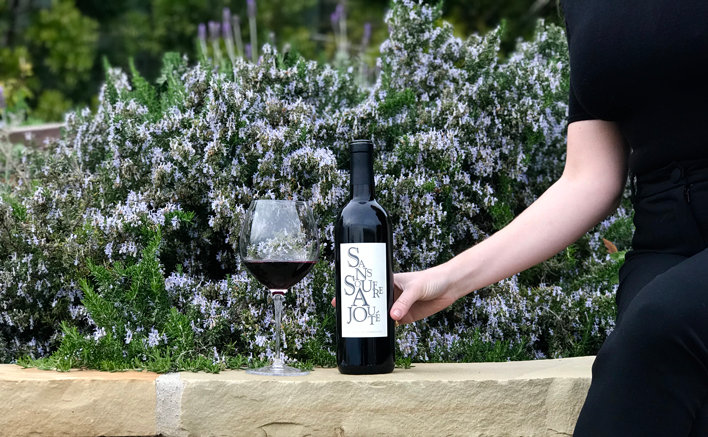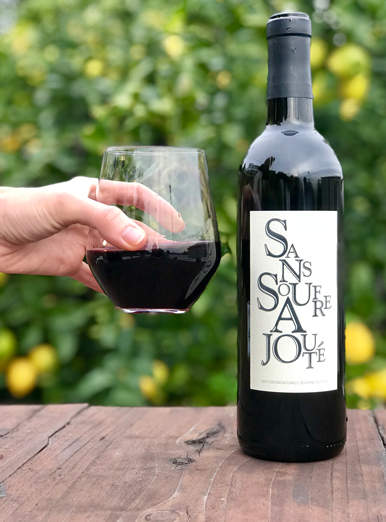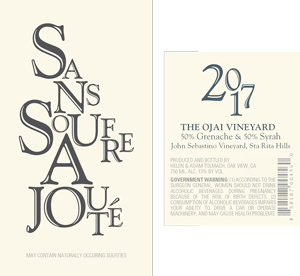
Introduction to SANS SOUFRE AJOUTÉ
We’ve just started pouring our new blend, Sans Soufre Ajouté (without sulfites added), a fresh and ready fusion of 50% Grenache and 50% Syrah that is crafted from grapes grown on the wind scoured slopes of John Sebastiano Vineyard in the Santa Rita Hills. This 2017 bottling reflects the culmination of six years of tinkering with sulfite-free wines, and now we are presenting the wine with a new and distinctive look.

So why use sulfites anyway? Sulfur dioxide (SO2) is an antioxidant, so when small amounts of oxygen cross through the cork into wine as it ages, the free SO2 binds to that oxygen and slows down the wine’s inevitable unraveling. Without SO2, wines can drink really well right out of the gate but usually last for only 5-6 years, well short of the 10-20 years one can expect out of our sulfited wines.
Since most people open wines within a year—if not a week—of buying them, why bother with sulfites at all? Well, sulfites also play a vital role as an antimicrobial. When a wine is just starting to ferment, it’s basically just a large volume of sugar-rich solution—fuel for the good yeast, but also for the detrimental bacteria and yeast floating around in the air. When these microbes land on a sugary substrate, they chow down and reproduce, often creating off-putting flavors and aromas. A small dose of SO2 before fermentation (we’re talking 20-25 parts per million) will kill off these feral bacteria and yeast.
Some people feel that any meddling with wine is unnatural, which has led to the popularity of the burgeoning natural wine movement and wine fairs like Raw Wine, an event The Ojai Vineyard crew carpooled to in November of 2018.
“The world’s largest community of low-intervention organic, biodynamic and natural wines, their growers & makers, and those who love drinking them,” Raw Wine is a pretty incredible event. The number of wines, regions, and producers is so extensive it would literally take all day to taste everything. After less than satisfying drinking experiences with high-end natural wines, we collectively talked about keeping an open mind and were pleased to encounter many delicious and interesting wines. However, many wines we tasted were deeply flawed—vinegary and vola
tile, or eggy/cabbagey. Some whites were nutty or flat from oxidation while some reds showed aromas of tomato paste, even nail polish remover (from ethyl acetate, a product of bacterial infection).
For some, wine can be fascinating when made in a way that is so honest that the maker does nothing to rectify these problems, and so some people adore these quirky, marred wines. There’s that idea of Wabi-sabi—the beauty in and because of imperfections. The charm of patina on an heirloom. A subtle thumbprint on a beautiful ceramic vase, divulging its handmade nature.
Perhaps people appreciate natural wines, even odd ones, as an antidote to the predictability of modern, technically precise wines. From that point of view, interventions like sulfur, cultured yeast, cross-flow filtration, and massive blending operations make for wine that is sanitized, boring, and soulless. Natural wines are just the opposite: wild, novel, full of potential narrative about interesting aging vessels and wine movements aligned with the lunar calendar.
But surely there must be something in between these two poles of natural and sanitized—a raw, fresh and soulful product that is honestly made and presented without sensory blemishes. Which brings us back to Adam and Sans Soufre Ajouté:
When you taste with Adam, there’s sometimes a wine he doesn’t adore but that he respects—he’ll say it’s “correct,“ by which he means it’s a sound wine, clean and varietally expressive, but not one he’ll remember. If you know Adam, you know there’s a painstaking attention to detail in everything he does in the cellar, even a healthy bit of paranoia. That’s imperative for pulling off a no-sulfites-added wine, and one can only assume there’s some of that same healthy fear and caution behind the better wines we tasted at RAW.
Sans Soufre Ajouté goes beyond mere correctness to achieve something far better. The fruit comes on with the juicy purity of a handful of ripe dark berries. Texturally, it has a feel that is bold and gulpable—the fruit is deep and saturating on the palate, but there are barely any perceptible tannins to contend with. It’s the perfect wine for a BBQ get-together where you want to share a wine that is interesting but also fun and easy-drinking. With the oddities involved with many no-sulfites-added wines, it’s unclear why this particular wine is so good. Maybe the winds that scour this hillside ensure clean, disease-free fruit that’s ripe and well balanced, which makes for a safer fermentation. Or maybe it’s Adam’s masterful attention to detail that helps the wine navigate around points of vulnerability. Who knows for sure? What’s clear is that our 2017 Sans Soufre Ajouté is, above all else, a wine crafted for raw and casual enjoyment—a true vin de soif (wine for thirst).
With the oddities involved with many no-sulfites-added wines, it’s unclear why this particular wine is so good. Maybe the winds that scour this hillside ensure clean, disease-free fruit that’s ripe and well balanced, which makes for a safer fermentation. Or maybe it’s Adam’s masterful attention to detail that helps the wine navigate around points of vulnerability. Who knows for sure? What’s clear is that our 2017 Sans Soufre Ajouté is, above all else, a wine crafted for raw and casual enjoyment—a true vin de soif (wine for thirst).
If you would like to taste Sans Soufre Ajouté for yourself click below to add to your cart, or email us and we will place the order for you!







